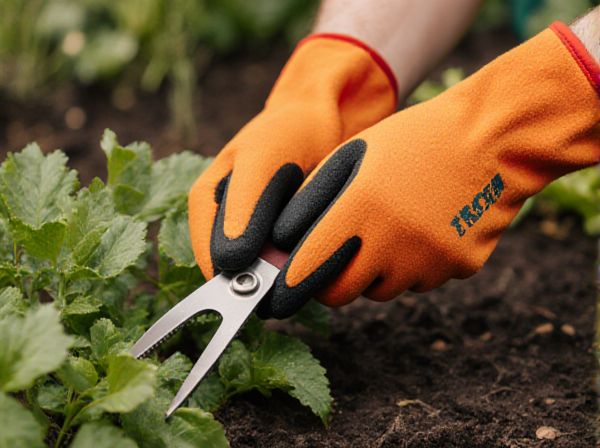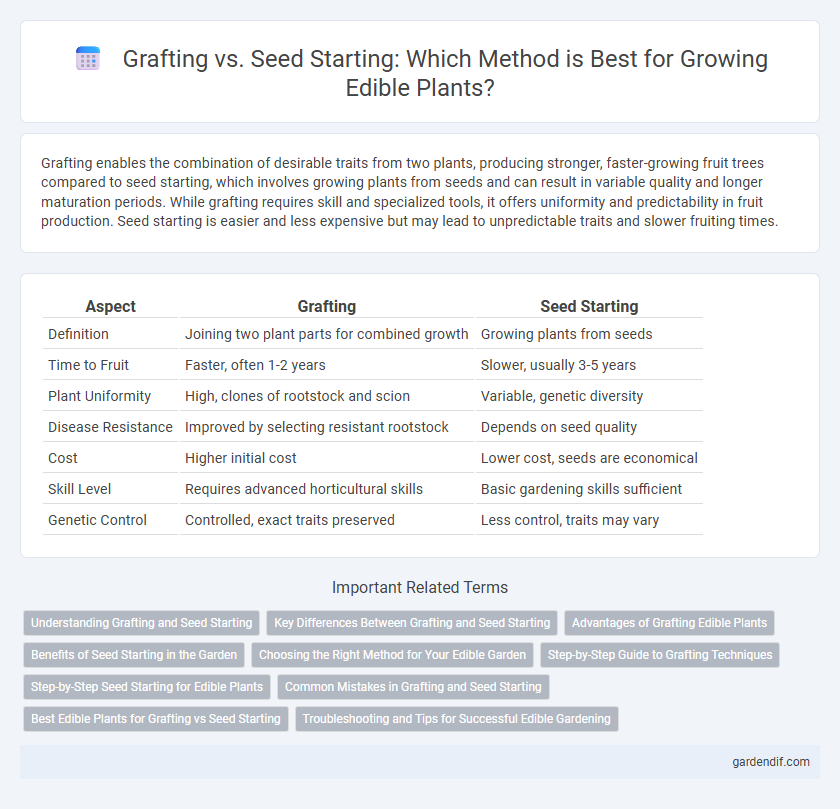
Grafting vs Seed Starting Illustration
Grafting enables the combination of desirable traits from two plants, producing stronger, faster-growing fruit trees compared to seed starting, which involves growing plants from seeds and can result in variable quality and longer maturation periods. While grafting requires skill and specialized tools, it offers uniformity and predictability in fruit production. Seed starting is easier and less expensive but may lead to unpredictable traits and slower fruiting times.
Table of Comparison
| Aspect | Grafting | Seed Starting |
|---|---|---|
| Definition | Joining two plant parts for combined growth | Growing plants from seeds |
| Time to Fruit | Faster, often 1-2 years | Slower, usually 3-5 years |
| Plant Uniformity | High, clones of rootstock and scion | Variable, genetic diversity |
| Disease Resistance | Improved by selecting resistant rootstock | Depends on seed quality |
| Cost | Higher initial cost | Lower cost, seeds are economical |
| Skill Level | Requires advanced horticultural skills | Basic gardening skills sufficient |
| Genetic Control | Controlled, exact traits preserved | Less control, traits may vary |
Understanding Grafting and Seed Starting
Grafting involves joining tissues from two plants to create a single, stronger organism, often improving disease resistance and fruit quality. Seed starting promotes genetic diversity and allows for the development of unique plant varieties tailored to specific growing conditions. Both methods are essential in edible plant cultivation, impacting growth speed, plant health, and yield potential.
Key Differences Between Grafting and Seed Starting
Grafting involves joining two plants to grow as one, promoting faster maturity and disease resistance compared to seed starting, which relies on germinating seeds. Seed starting allows for genetic diversity and is typically easier for beginners, but grafting offers improved control over plant traits and fruit quality. Key differences include growth speed, genetic uniformity, and the complexity of the propagation process.
Advantages of Grafting Edible Plants
Grafting edible plants promotes faster fruit production by combining the rootstock's vigor with the desired variety's qualities, leading to earlier harvests compared to seed starting. It ensures genetic consistency, maintaining desired traits like flavor and disease resistance, which seed starting from open-pollinated seeds may not guarantee. Grafting also enhances plant resilience against soil-borne diseases and adverse conditions, improving overall crop success and yield.
Benefits of Seed Starting in the Garden
Seed starting in the garden promotes genetic diversity and adaptability, resulting in healthier, more resilient plants. This method enables precise control over growing conditions such as soil quality, moisture, and temperature, fostering optimal germination rates. Starting seeds also allows for a wider selection of plant varieties, including rare and heirloom species not available through grafting.
Choosing the Right Method for Your Edible Garden
Grafting offers rapid fruit production and disease-resistant plants, making it ideal for specialty fruit trees or heirloom varieties in edible gardens. Seed starting provides genetic diversity and cost-effectiveness, allowing gardeners to cultivate a wide range of vegetables and herbs from scratch. Selecting the right method depends on desired crop traits, time constraints, and garden goals for maximizing yield and plant health.
Step-by-Step Guide to Grafting Techniques
Grafting techniques begin by selecting healthy rootstock and scion with compatible cambium layers for successful nutrient transfer. Make precise cuts using a sharp knife to create matching surfaces, then securely bind the graft union with grafting tape or rubber bands to prevent desiccation. Maintaining appropriate humidity and temperature during the healing period enhances callus formation, ensuring strong vascular connection and optimal growth in edible plants.
Step-by-Step Seed Starting for Edible Plants
Start by selecting high-quality seeds tailored for edible plants like tomatoes, peppers, or lettuce, ensuring optimal germination. Prepare a sterile seed-starting mix and plant seeds at the recommended depth, maintaining consistent moisture and warmth of around 70-75degF (21-24degC) for faster sprouting. Provide adequate light using grow lights or a sunny windowsill, and gradually acclimate seedlings to outdoor conditions before transplanting to the garden for robust growth and higher yields.
Common Mistakes in Grafting and Seed Starting
Common mistakes in grafting include improper alignment of the rootstock and scion, leading to poor vascular connection and graft failure. In seed starting, errors such as planting seeds too deep, inconsistent moisture levels, and inadequate light can cause weak or failed seedlings. Both methods require careful attention to timing and environmental conditions for successful plant propagation.
Best Edible Plants for Grafting vs Seed Starting
Grafting is ideal for fruit trees like apples, pears, and citrus, as it ensures faster fruit production and retains desirable traits from the parent plant. Seed starting suits vegetables such as tomatoes, peppers, and lettuces, offering genetic diversity and cost efficiency. For herbs like basil and mint, seed starting promotes adaptability, while grafting can enhance disease resistance in rootstocks.
Troubleshooting and Tips for Successful Edible Gardening
Grafting edible plants offers faster fruit production and disease resistance but requires precise cuts and compatible rootstocks to avoid failure, while seed starting demands consistent moisture and temperature control to ensure germination. Troubleshoot common grafting issues like callus formation and graft union failure by maintaining high humidity and using clean tools; for seeds, prevent damping-off disease by using sterile soil and proper ventilation. Successful edible gardening combines grafting's vigor with seed starting's genetic variety by monitoring environmental conditions and promptly addressing signs of stress or infection.
Grafting vs Seed Starting Infographic

 gardendif.com
gardendif.com